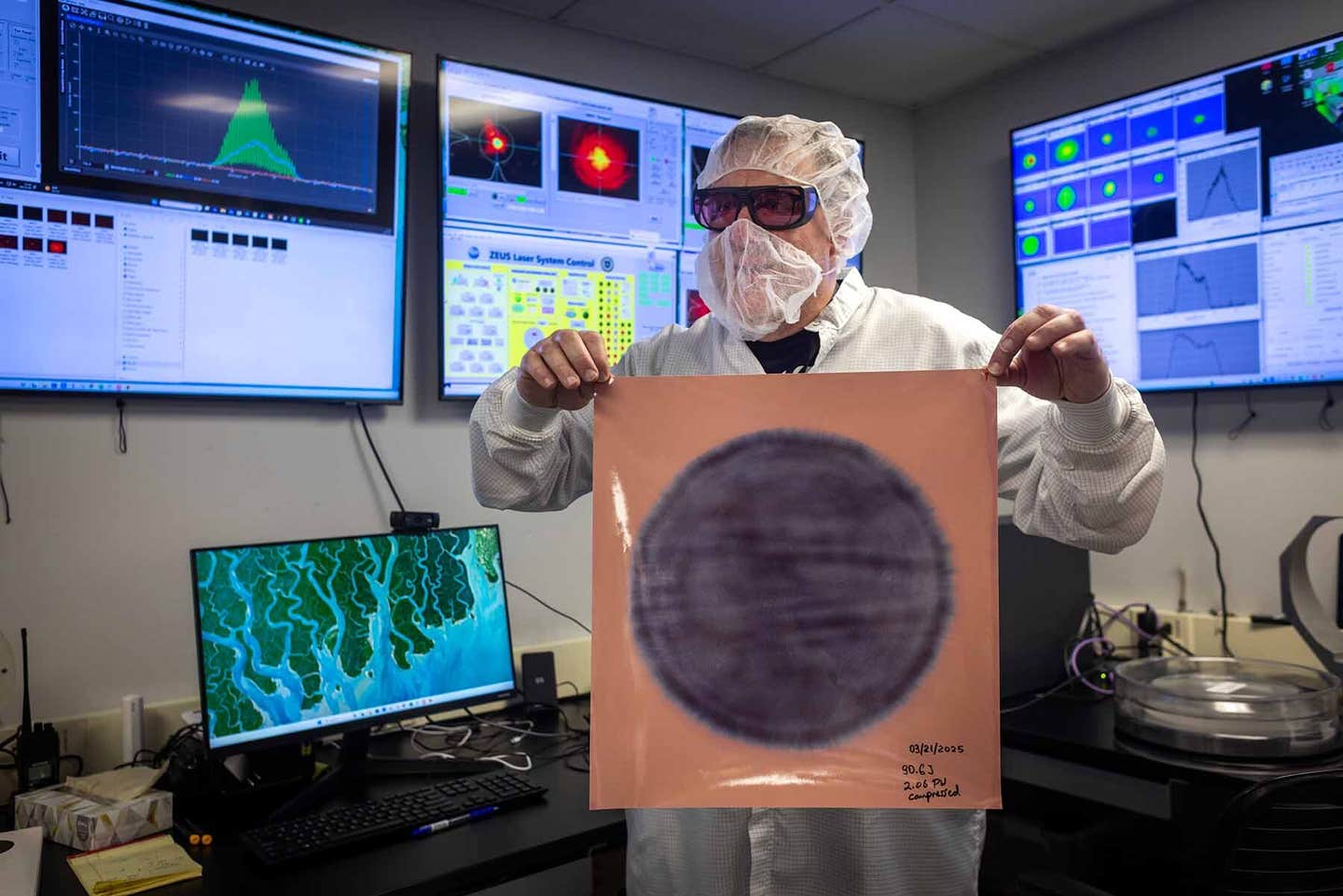Scientists fire most powerful US laser ever—100 times Earth’s total energy usage
The ZEUS laser at the University of Michigan reached 2 petawatts, opening new frontiers in physics, medicine, and particle research.

Gregg Sucha, laser engineer, holds up a laser burn mark on photographic paper in a control room of the ZEUS lab. (CREDIT: Marcin Szczepanski, Michigan Engineering)
A school gym-sized facility tucked away at the University of Michigan is quietly pushing the boundaries of what lasers can do. Known as ZEUS—short for Zettawatt Equivalent Ultrashort laser pulse System—it recently achieved a record-setting peak power of 2 petawatts. That’s 2 quadrillion watts, a burst more than 100 times the power used by the entire planet. This extraordinary pulse lasted just 25 quintillionths of a second, yet it opens the door to a new era of scientific exploration.
“This milestone marks the beginning of experiments that move into unexplored territory for American high field science,” said Karl Krushelnick, director of the Gérard Mourou Center for Ultrafast Optical Science. With its sights set on quantum physics, plasma science, astrophysics, and more, ZEUS is already reshaping what's possible in high-intensity laser research.
Bursts of Light and the Edge of Physics
ZEUS builds on the legacy of its predecessor, HERCULES, which topped out at 300 terawatts. ZEUS multiplies that power by nearly seven. As a pulsed laser, it releases ultra-short bursts of light so intense that they require protective concrete shielding nearly two feet thick. Even in this tightly controlled setting, the laser’s energy is strong enough to tear electrons off atoms and create plasma—a churning soup of ions and electrons.
By firing the laser into helium gas, researchers create waves in the plasma that electrons can “surf,” a process called wakefield acceleration. Using a longer, less dense gas cell allows electrons more room and time to gain speed. As a result, they reach energy levels previously thought impossible without massive particle accelerators.
At full power, ZEUS will perform a head-on collision between a stream of accelerated electrons and another laser pulse. Although this second pulse will only measure 3 petawatts, in the frame of reference of the speeding electrons, it will seem a million times more intense—a virtual zettawatt burst. That’s the inspiration behind ZEUS’s full name.
Designed for Discovery and Collaboration
Backed by $16 million in funding from the National Science Foundation, ZEUS isn’t just a Michigan project. It’s a national research tool that welcomes outside scientists. Proposals from across the country and even internationally are selected through a peer-review process.
Related Stories
Franklin Dollar from the University of California, Irvine, leads the first official user experiment. His team aims to create electron beams with energies five to ten times higher than anything previously achieved at ZEUS. These would rival beams generated by traditional accelerators that are hundreds of meters long.
“One of the great things about ZEUS is it’s not just one big laser hammer,” Dollar said. “You can split the light into multiple beams.” This flexibility makes ZEUS unique, offering multiple experimental setups in a single facility.
Vyacheslav Lukin, program director in the NSF’s Division of Physics, emphasized the wide impact of ZEUS. “The fundamental research done at the NSF ZEUS facility has many possible applications, including better imaging methods for soft tissues and advancing the technology used to treat cancer and other diseases.”
Behind the Beam: How ZEUS Works
To create its immense bursts of light, ZEUS starts with an infrared pulse. Optical gratings stretch it out in time, preventing the pulse from becoming too intense too quickly. Through four stages of amplification, the laser is built up to full power. At one point, the beam stretches 12 inches wide and several feet long. But before hitting the target, it’s squeezed down to less than a micron in width.
This focus raises intensity to a staggering level—enough to trigger exotic physics, such as particle creation and quantum field effects that are typically only seen near black holes or in particle accelerators. It’s this power that makes ZEUS such a valuable scientific tool.
Despite its size and complexity, ZEUS is nimble. “As a midscale-sized facility, we can operate more nimbly than large-scale facilities like particle accelerators or the National Ignition Facility,” said John Nees, who leads laser construction at ZEUS. “This openness attracts new ideas from a broader community of scientists.”
The Road to Full Power
Reaching 2 petawatts was no easy feat. The system required years of careful planning and sourcing rare materials. One of the biggest hurdles was acquiring a specialized titanium-doped sapphire crystal nearly 7 inches in diameter. It serves as the final amplifier for the beam and took four and a half years to produce.
Even after hitting 1 petawatt, the team noticed troubling signs. The optical gratings darkened, raising fears of permanent damage. Fortunately, testing revealed it was only carbon deposits from stray molecules being ripped apart by the laser. After confirming this, researchers figured out how many shots could be fired safely before cleaning became necessary.
So far, ZEUS has hosted 11 different experiments involving 58 scientists from 22 institutions. While the current laser is powerful, many researchers are already gearing up for the next stage: reaching 3 petawatts. Once the new sapphire crystal is installed, the laser’s true potential will be realized.
Looking ahead, the ZEUS team will continue to support outside researchers while making upgrades between experiments. By allowing broad access to such advanced technology, ZEUS is positioning the United States to regain leadership in ultrafast laser science.
As Krushelnick, who also holds multiple professorships in engineering and physics, noted, this new frontier is about more than just power. It's about discovery. It's about enabling the kinds of experiments that can unlock deeper understanding of matter, energy, and the forces that shape the universe.
Most Powerful Lasers on Earth
Here are the five most powerful lasers on Earth as of mid-2025, ranked by their peak power output in petawatts (PW). These lasers are designed for cutting-edge physics experiments, including fusion research, high-energy density science, and probing the fundamental nature of matter.
1. ELI-NP Laser (Romania)
- Power: 10 petawatts (PW) per beam, 20 PW total
- Location: Măgurele, Romania
- Facility: Extreme Light Infrastructure – Nuclear Physics (ELI-NP)
- Purpose: Research in nuclear photonics, quantum electrodynamics, and high-intensity laser-matter interactions.
2. SULF Laser (China)
- Power: 10 PW
- Location: Shanghai, China
- Facility: Shanghai Superintense Ultrafast Laser Facility (SULF)
- Purpose: High-field physics and quantum electrodynamics using ultra-short femtosecond pulses.
3. Apollon Laser (France)
- Power: 5 PW (planned upgrade to 10 PW)
- Location: Paris-Saclay, France
- Facility: Laboratoire d'Utilisation des Lasers Intenses (LULI)
- Purpose: Studies of relativistic laser-plasma interactions and high-energy particle acceleration.
4. ZEUS Laser (USA)
- Power: 3 PW (expandable to 20 PW in future stages)
- Location: University of Michigan, Ann Arbor, USA
- Facility: ZEUS (Zettawatt-Equivalent Ultrashort pulse laser System)
- Purpose: Simulates extreme astrophysical environments and supports advanced particle physics experiments.
5. Vulcan Laser (UK)
- Power: 1 PW (upgrade to 20 PW planned)
- Location: Rutherford Appleton Laboratory, Oxfordshire, UK
- Facility: Central Laser Facility
- Purpose: High-energy-density physics, inertial confinement fusion, and laser-driven particle acceleration.
These lasers represent the pinnacle of photonics and are essential tools for next-generation physics, nuclear fusion, and probing the quantum vacuum.
Note: The article above provided above by The Brighter Side of News.
Like these kind of feel good stories? Get The Brighter Side of News' newsletter.



